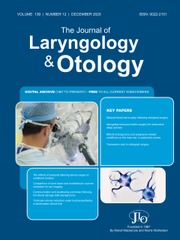No CrossRef data available.
Article contents
Measuring the cochlea: comparison between otoplan and curved multiplanar reconstruction and literature review
Published online by Cambridge University Press: 06 August 2025
Abstract
To compare two high-resolution computerised tomography based pre-surgical planning software in measuring the cochlear dimensions, which can aid in designing/choosing customised cochlear implant electrodes.
A cross-sectional-observational study was conducted in a tertiary care centre using high-resolution computerised tomography–supported software Otoplan and curved multi-planar reconstruction to find cochlear duct length’s maximum and minimum width/diameter and height in 110 ears (55 subjects). Measurements and the time taken by both techniques were compared.
There were no significant differences in the measurements taken with the two software; however, the time taken for analysis was significantly higher for curved multi-planar reconstruction than with Otoplan.
The steep learning curve, the need for an expert radiologist and the difficulty of use are factors that significantly limit the use of curved multi-planar reconstruction. Otoplan requires less time and can be operated even by someone with less expertise in measuring cochlear dimensions for pre-surgical planning and research.
Information
- Type
- Review Article
- Information
- Copyright
- © The Author(s), 2025. Published by Cambridge University Press on behalf of J.L.O. (1984) LIMITED.
Footnotes
Manu Malhotra takes responsibility for the integrity of the content of the paper.

